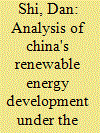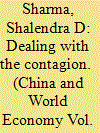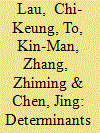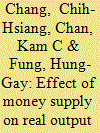|
|
|
Sort Order |
|
|
|
Items / Page
|
|
|
|
|
|
|
| Srl | Item |
| 1 |
ID:
086616


|
|
|
|
|
| Publication |
2009.
|
| Summary/Abstract |
At present, the development of renewable energy relies mainly on government support. The government invests in a considerable number of projects to improve public welfare and to assist in poverty relief. If China is to replace fossil fuels on a large scale with renewable energy sources, the production costs and prices of renewable energy must be brought down. All countries are facing the challenge of moving to a more secure and low-carbon energy system without weakening economic and social development. In this regard, China is facing an even greater challenge in terms of economic cost, as cheap coal remains the main energy form. Technical innovation and industrialization in the area of renewable energy is an important means of lowering cost. China is in for a period of high-speed development of its economy and the rising demand for energy is irreversible. If the technical progress and development speed of renewable energy lags behind the growth in demand, it will be difficult to realize the improvement of its energy structure.
|
|
|
|
|
|
|
|
|
|
|
|
|
|
|
|
| 2 |
ID:
086602


|
|
|
|
|
| Publication |
2009.
|
| Summary/Abstract |
What began as a downturn in the US housing sector in the summer of 2007 had mushroomed into a global financial crisis by September 2008: the most severe since the 1930s. Developing countries, including China and India, at first seemingly sheltered from the worst of the turmoil, have not been immune to the contagion's spillover effects. What are China and India's precise vulnerabilities, and what can each do to better insulate their economies from the vagaries of global financial marker turmoil? Equally important, what long-term strategies must each country adopt to make their economies more resilient to global market downturns?
|
|
|
|
|
|
|
|
|
|
|
|
|
|
|
|
| 3 |
ID:
086609


|
|
|
|
|
| Publication |
2009.
|
| Summary/Abstract |
This paper attempts to explore key determinants of competitiveness in the textile and apparel industries, with special reference to Chinese Mainland. The authors conduct a survey that is designed to use productivity, supply-side and demand-side determinants to measure enterprises' competitiveness. The collected survey data is then analyzed using factor analysis to capture the related determining factors indicative of competitiveness at the enterprise level. The findings demonstrate that government policies and related industry infrastructure are the most important determinants of competitiveness in the textile and apparel industries, followed by domestic demand. This suggests that the improvement of industry infrastructure can foster industry performance, and that more resources should be endowed to enhance the domestic business competitiveness of local enterprises. The development of domestic demand will foster the competitiveness of the textile and apparel industries on a more sustainable basis.
|
|
|
|
|
|
|
|
|
|
|
|
|
|
|
|
| 4 |
ID:
086606


|
|
|
|
|
| Publication |
2009.
|
| Summary/Abstract |
Over the past 30 years, China has achieved remarkable long-term economic growth. Using quarterly data, we study the effects of money supply on real output and inflation in China between 1993 and 2008. To this end, we use money supply shocks after filtering out the expected component of the money supply. Our findings provide evidence supporting the asymmetric effect of positive and negative money supply shocks on real output and inflation in China. That is, real GDP growth in China responds to negative money supply shocks but not positive money supply shocks. In addition, inflation responds to positive money supply shocks but not negative money supply shocks. We conclude that the People's Bank of China's policy of steady monetary growth appears to be appropriate. Our study offers important policy implications for China.
|
|
|
|
|
|
|
|
|
|
|
|
|
|
|
|
| 5 |
ID:
086603


|
|
|
|
|
| Publication |
2009.
|
| Summary/Abstract |
Using panel data for 29 provinces in China during 1990-2004, the present paper attempts to explore a possible link between financial development and China's foreign trade. Three measures of comparative advantage in manufactured goods have been applied in our study, including Balassa's revealed comparative advantage, the net manufactured export index, and the Michaely index. We also use four indicators of financial development to identify the different functions of regional financial development, and to determine both size and efficiency features of financial institutions. The estimation results suggest that besides factor endowments, foreign firms and infrastructure, financial development has a quantitatively large and robust effect on China's manufactured goods trade. Therefore, further reform of China's financial system should be encouraged to fully exploit the comparative advantage of China's foreign trade.
|
|
|
|
|
|
|
|
|
|
|
|
|
|
|
|
| 6 |
ID:
086614


|
|
|
|
|
| Publication |
2009.
|
| Summary/Abstract |
Using data at micro and city levels, the present paper explores the policy evolution of the minimum wage system in China, and examines its coverage for migrant workers. The analysis indicates that minimum wage policy has been substantially improved in terms of both coverage and the level of the minimum wage standard, but that the current policy tool that relies on the monthly wage rate is not effective. Because migrant workers tend to work more hours, use of an hourly wage rate is more appropriate than a monthly wage rate.
|
|
|
|
|
|
|
|
|
|
|
|
|
|
|
|
| 7 |
ID:
086610


|
|
|
|
|
| Publication |
2009.
|
| Summary/Abstract |
In July 2005, the Chinese Government unpegged the RMB from the US dollar. As the RMB has followed a remarkably predictable appreciation over time, I examine the price of Chinese exports to the USA after unpegging the exchange rate. Results suggest that the Chinese industries with greater import market share were able to raise their prices after the removal of the pegged exchange rate regime; however, over time there is a significant deflationary trend. Chinese export prices tended to decrease under an unanticipated RMB appreciation; this effect was more pronounced for industries with more pricing flexibility. This suggests that Chinese exporters are consistently "pricing to market" and thus creating a significant foreign exchange policy implication. Specifically, a more flexible exchange rate regime will likely have little impact on the prices of Chinese exports to the USA but might increase the profit volatility of Chinese firms.
|
|
|
|
|
|
|
|
|
|
|
|
|
|
|
|
| 8 |
ID:
086617


|
|
|
|
|
| Publication |
2009.
|
| Summary/Abstract |
This paper studies the rise and fall of the first financial futures market in China. We compare the characteristics in the Chinese Government bond futures market with those in the US T-bond futures market. They differ in market design and structure, market governance, margin requirements, position limits, delivery process, and the way in which the settlement price is calculated. Furthermore, with a unique dataset, we show that prior to maturities of government bond futures, traders began to accumulate significant amounts of long positions for several selected contracts without the intention to offset, forcing short position holders to either purchase deliverable bonds or offset futures at highly inflated prices, causing higher market volatility and price disequilibrium in both spot and futures markets. Arbitrage opportunity arises and the market eventually collapses. The lessons learned from the suspension of the Chinese Government bond futures market offer an invaluable learning experience.
|
|
|
|
|
|
|
|
|
|
|
|
|
|
|
|
|
|
|
|
|